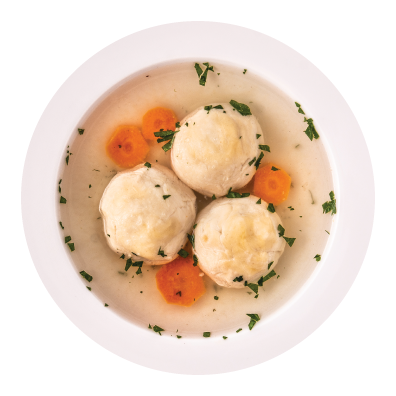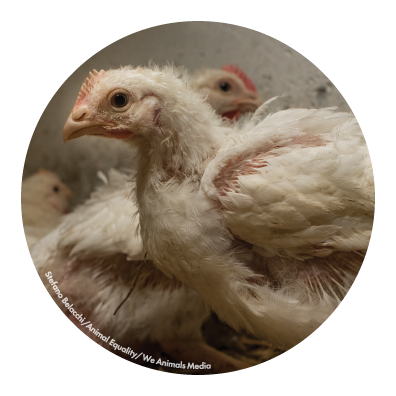The discomfort of chicken soup
Take Action
Virtually all kosher chickens, cattle, and fish suffer the worst abuses of factory farming, and everyone pays the price. Help your community transition to more humane and sustainable food practices with new resources, consultation, and training.
From schnitzel to matzo ball soup, Jewish culinary tradition makes frequent use of chicken.
The birds have lived with Jewish communities for millennia, domesticated 4,000–10,000 years ago. Historically, however, chicken was never consumed in the quantities most people in the industrialized world eat today.
In 1948, the USDA and the US’s largest supermarket chain put on the ‘Chicken of Tomorrow’ contest. Their primary aim was to breed a chicken that grows faster while eating less feed, and they succeeded more than anyone expected. The winners of that contest went on to develop complex new “hybrid” breeding techniques never before used in the history of poultry production. Thus began an explosion in chicken production and popularity: the USDA calculates that chicken consumption has increased by 540 percent between 1910 and 2021.
Today, chickens raised for their meat are referred to as “broiler chickens” while those who produce eggs are “laying hens.” Although the two animals are technically the same—both G. gallus domesticus—each have different bodies with different issues due to bifurcation of the industries. Over the past 50+ years, factory farms have bred hundreds of generations of broiler chickens and laying hens, selecting genes so that the birds produce more meat or eggs, respectively.
Broilers have been aggressively bred for rapid muscle growth (“meat” being muscle), resulting in rampant lameness. Chickens have more than doubled in size over the past few decades, and deliberately breeding for high muscle-to-bone ratio means that chickens today are too heavy for their own skeletons to support. Organ stress is common, their hearts struggling to pump blood throughout such massive bodies. Birds normally suffer from degenerative joint disease, so they spend most of their time sitting or lying on waste-soaked litter. Factory farms don’t provide enrichment opportunities for the birds—let alone outdoor access—denying chickens the chance to perch or investigate as they naturally would. Broiler chickens are slaughtered around 7 weeks of age. Genetically healthy chickens, by contrast, can live out a natural lifespan of 10 or more years.
An estimated 10 billion broilers are killed in the US every year, and 70 billion worldwide. There is no legal limit to how large American chicken farms can be, and since agriculture favors economies of scale, a typical shed “houses” thousands of birds. With factory farms preferring to set up shop in rural areas, chicken populations normally outnumber neighboring human communities more than ten-to-one, leaving neighbors feeling powerless against industry interests. It’s not just birds who suffer from massive farms but nearby communities, waterways, and wildlife too. Moreover, the industry is rife with labor justice issues—from farmers who are coerced into indentured servitude to impoverished, primarily BIPOC and immigrant workers who endure some of the most dangerous jobs in slaughter and processing plants.
Factory farmed poultry also poses a public health threat to people everywhere, even though these chickens are produced far from the urban centers where they’re purchased by the millions. With hundreds of thousands of immunocompromised, genetically manipulated birds housed in filthy, crowded barns, industrial poultry farms are uniquely suited for generating new pathogens and potential pandemics. In fact, most of the influenza viruses with pandemic potential deemed “of special concern” by the CDC arose from commercial poultry operations. Scientists are keeping close watch on the current highly contagious H5N1 bird flu that has decimated egg production and hen populations (58 million birds have died or been euthanized to try to stop its spread.) Scientists are even developing vaccines for a potential human outbreak. Complicating health matters further, the chicken industry’s perpetual overuse of drugs, including antibiotics, is driving widespread antimicrobial resistance. As journalist Maryn McKenna reports, we may be turning back the clock on the pharmacological breakthroughs that revolutionized medicine and human health.
From animal welfare to labor justice to public health, there are many Jewish values-based reasons to commit to alternatives to industrial poultry.

